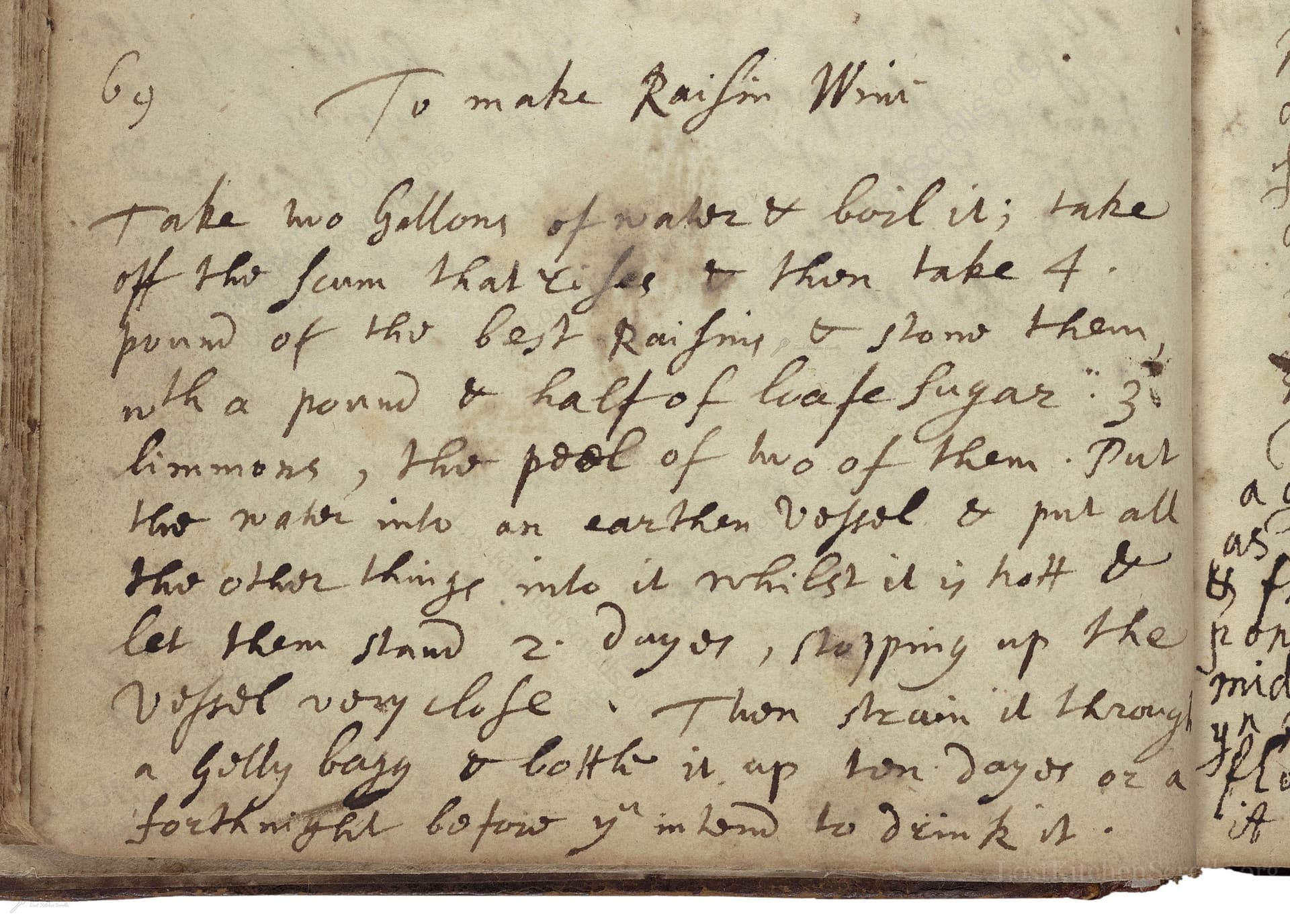To Make Raisin Wine
From the treasured pages of Receipt book of Penelope Jephson
Written by Penelope Patrick

To Make Raisin Wine
"Take two Gallons of water & boil it; take of the scum that rises & then take 4 pound of the best Raisins & stone them with a pound & half of loafe Sugar: 3 lemmons, the peel of two of them. Putt the water into an earthen Vessel & put all the other things into it whilst it is hott & let them stand 2. Dayes, stopping up the vessel very close. Then strain it thro a Gelly bagg & bottle it up ten Dayes or a fortnight before yu intend to drink it."
Note on the Original Text
The recipe is written in a conversational and instructive style typical of 17th-century English household manuscripts, with informal measurements (such as 'pound' and 'gallon') that local cooks could easily understand. Spelling follows period conventions—'lemon', for instance, is spelled 'lemmon', and words are joined by ampersands for efficiency. Recipes of this era rely on experience, assuming the cook knows certain culinary basics (such as how to skim a boiling liquid or use a jelly bag), as precise temperatures or timings were less often specified. The focus is on process and ingredient quality over exact standards—a creative and adaptive approach to home wine-making.

Title
Receipt book of Penelope Jephson (1673)
You can also click the book image above to peruse the original tome
Writer
Penelope Patrick
Era
1673
Publisher
Unknown
Background
Step back into the sumptuous kitchens of the late 17th century with Penelope Patrick’s culinary collection—a feast of historic recipes, secret tips, and the irresistible flavors of Restoration England all bound together in a handwritten treasure.
Kindly made available by
Folger Shakespeare Library
This recipe is drawn from the late 17th-century manuscript of Penelope Patrick (1646-1725), dating to the 1670s. In an age when imported wines could be costly or hard to obtain in England, households made fruit wines as a delicious, practical alternative. Raisin wine, in particular, was valued for both its sweetness and shelf-stability, and was often enjoyed as a celebration wine or offered to guests. Homemakers, often gentlewomen like Penelope Patrick, meticulously recorded such recipes in personal collections, blending tradition with experimentation as they adapted ingredients to the season and their social status. This recipe is a snapshot of culinary ingenuity in Restoration-era England.

The equipment used would have included a large copper or earthenware kettle for boiling water, a substantial earthenware or glazed ceramic vessel for steeping the mixture, a jelly bag (a fine cloth bag used for straining), and glass bottles sealed with corks or wax for storage. A wooden muddling spoon or mallet may have been used for bruising the raisins, and a sharp knife for preparing lemons. The whole process required attentive hands and a cool pantry for fermenting and storage.
Prep Time
35 mins
Cook Time
15 mins
Servings
10
We've done our best to adapt this historical recipe for modern kitchens, but some details may still need refinement. We warmly welcome feedback from fellow cooks and culinary historians — your insights support the entire community!
Ingredients
- 2 gallons water
- 4 pounds raisins (Thompson or Sultana recommended), de-stoned
- 1.5 pounds white granulated sugar (substitute for loaf sugar)
- 3 lemons (peel of 2, juice of all 3)
- Optional: Extra lemon peel for garnish or more brightness
Instructions
- Begin by bringing 2 gallons of water to a rolling boil in a large pot, skimming off any foam that appears.
- While the water is heating, prepare your fruit: de-stone 4 pounds of high-quality raisins and roughly chop them.
- Combine these with 1.5 pounds of white granulated sugar (as a stand-in for the historical loaf sugar) and the peel of 2 lemons, plus the juice from 3 lemons.
- Place all these ingredients into a large ceramic or glass vessel.
- Immediately pour over the freshly boiled water while it is still hot.
- Cover the vessel tightly and let the mixture steep for 2 days at room temperature.
- After this infusion period, strain the mixture through a fine jelly bag or clean muslin cloth to remove solids, then decant the liquid into sterilized bottles.
- Allow the bottles to rest in a cool, dark place for 10 to 14 days before serving, to let the flavors mature and the wine to clarify.
Estimated Calories
210 per serving
Cooking Estimates
Preparing this raisin wine takes about 35 minutes for prepping all ingredients and boiling the water. The actual cooking (boiling the water) is about 15 minutes. After that, the mixture needs to steep for 2 days and rest for 10–14 days before it's ready to drink, but this doesn't need you to watch it. Each batch makes about 10 servings, and each one has roughly 210 calories. Time and calories may vary based on serving size and raisin variety.
As noted above, we have made our best effort to translate and adapt this historical recipe for modern kitchens, taking into account ingredients nowadays, cooking techniques, measurements, and so on. However, historical recipes often contain assumptions that require interpretation.
We'd love for anyone to help improve these adaptations. Community contributions are highly welcome. If you have suggestions, corrections, or cooking tips based on your experience with this recipe, please share them below.
Join the Discussion
Rate This Recipe
Dietary Preference
Main Ingredients
Culinary Technique

Den Bockfisch In Einer Fleisch Suppen Zu Kochen
This recipe hails from a German manuscript cookbook compiled in 1696, a time whe...

Die Grieß Nudlen Zumachen
This recipe comes from a rather mysterious manuscript cookbook, penned anonymous...

Ein Boudain
This recipe comes from an anonymous German-language manuscript cookbook from 169...

Ein Gesaltzen Citroni
This recipe, dating from 1696, comes from an extensive anonymous German cookbook...
Browse our complete collection of time-honored recipes



